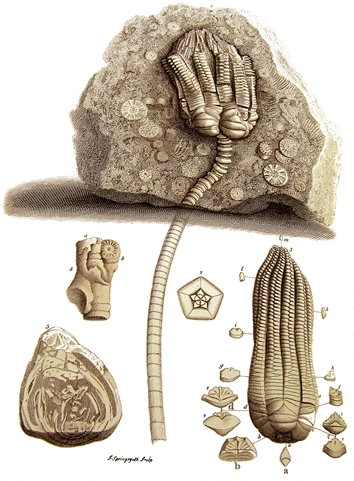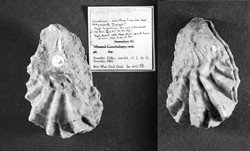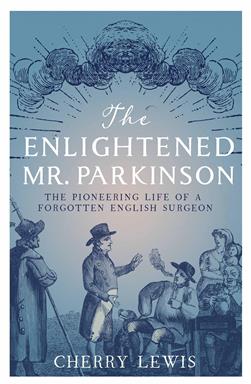Cherry Lewis* examines the geological life and work of Society Founder and medical pioneer, James Parkinson
 This year we celebrate 200 years since publication of a medical classic – James Parkinson’s Essay on the Shaking Palsy, the condition which subsequently became known as Parkinson’s disease. In 1817 Parkinson was the first to define the condition and identify the symptoms with which we still diagnose the disease today. ‘Very interesting’, I hear you say, ‘but what’s this got to do with geology?’
This year we celebrate 200 years since publication of a medical classic – James Parkinson’s Essay on the Shaking Palsy, the condition which subsequently became known as Parkinson’s disease. In 1817 Parkinson was the first to define the condition and identify the symptoms with which we still diagnose the disease today. ‘Very interesting’, I hear you say, ‘but what’s this got to do with geology?’
Background
James Parkinson was born on 11 April 1755, the eldest of three children who survived to adulthood. No genuine photo of him exists, despite those you can find on the Internet, because he died before photography was invented. He was an apothecary surgeon (fulfilling a role much the same as today’s GP) and spent his whole life in Hoxton, then a small village on the outskirts of London.
Picture: Stone Lily, ORFW v2, plate XIV
In 1785 Parkinson attended lectures given by the famous surgeon, John Hunter. Above Hunter’s lecture theatre were another two floors that housed his spectacular natural history collection, which included nearly 3000 fossils. Parkinson later recalled how, from the moment of seeing that ‘splendid and beautifully illustrative Collection’1 he began collecting fossils. It became a passion that was to dominate the rest of his life.
Former world
By Parkinson’s time (1755-1824) the theory that fossils were the remains of animals and plants prevailed, but there was still the considerable difficulty of explaining how the remains of sea-dwelling creatures could be found inland, high above sea level. Furthermore, while some fossils were relatively easy to identify, being almost identical to their modern-day counterparts, others either had no modern analogues or, more worryingly, appeared to resemble exotic species now found only in the tropics. It was all very confusing and further confounded by the fact that beneath all the rationalism and worldliness of the Enlightenment, religion remained at the heart of most people’s understanding of the world.
 Picture: Parkinson's microscope, which he gave to Edward Jenner.
Picture: Parkinson's microscope, which he gave to Edward Jenner.
As his collection grew, Parkinson found it increasingly difficult to identify and classify many of its rare and beautiful specimens because little had been written on the subject in English. He therefore decided ‘to take on himself the task of accomplishing, to the best of his abilities, a work of that description’.2 But before he could begin there were several problems he had to overcome. First, there was no terminology with which to describe this new science; the word geology was not yet in regular use, the word ‘fossil’ meant anything dug out of the Earth, including minerals and archaeological artefacts, and the word palaeontology would not be coined until 1822. Furthermore, he was aware of the advice given to John Hunter who had used the term ‘many thousand centuries’ when referring to the age of fossils:
‘there are persons, very numerous and very respectable in every point but their pardonable superstitions, who will dislike any mention of a specific period that ascends beyond 6000 years; I would therefore, with submission, qualify the expression by many thousand “YEARS” instead of “CENTURIES.”’3
.jpg?h=505&w=344&la=en) It was this same audience of very respectable persons with their pardonable superstitions to whom Parkinson addressed his volumes, so he had good reason to be cautious. Nevertheless, despite his trepidations, he was determined to face the challenge and ‘prosecute it with fairness; to shrink from no question on account of its supposed tenderness; and to conceal no conclusion, however repugnant to popular opinion or prejudice’.4 He was not going to shirk the truth, even if it revealed the Bible to be wrong.
It was this same audience of very respectable persons with their pardonable superstitions to whom Parkinson addressed his volumes, so he had good reason to be cautious. Nevertheless, despite his trepidations, he was determined to face the challenge and ‘prosecute it with fairness; to shrink from no question on account of its supposed tenderness; and to conceal no conclusion, however repugnant to popular opinion or prejudice’.4 He was not going to shirk the truth, even if it revealed the Bible to be wrong.
Textbook
Picture: Fossil sea urchins, ORFW
The first volume of James Parkinson’s Organic Remains of a Former World was published on 1 June 1804, and two others followed in 1808 and 1811. Although ultimately a textbook, Organic Remains started as a series of letters between an ‘expert’ in geology and his intensely curious, but rather ignorant, friend. Parkinson, of course, played both roles. But as his expertise increased, the later volumes portray a scientist at work, no longer interested in fossils purely for their beauty, but diligently examining every fragment for the information that it could provide. And always in the back of Parkinson’s mind was the astonishing question – how did fossils turn to stone?
Attempting to answer this, he studied them with a hand lens, in polished sections, and even by shining a light through thin slices under a microscope, much as we might do today. He also performed chemical experiments in fossils in the hope of finding evidence of the original animal. Unfortunately, his practice kept him so busy that he had little time to go into the field to look for specimens himself, as evidenced by one reader who wrote in the margin of the first volume: ‘No one would think this writer had ever wandered further than ye sound of Bow Bells’.5
Publication of these volumes made Parkinson internationally famous and many fossils were named in his honour, so his inclusion as a founder member of the Geological Society in 1807 was a foregone conclusion. Described as ‘not merely the best but almost the only fossilist of his day’,6 it was Parkinson who championed William Smith’s methods within the Society, complaining that members did not understand the true significance of fossils and how they could be used to elucidate geology.7
.jpg?h=171&w=249&la=en) Golden age
Golden age
Picture: Ostrea and Gryphaea
At the time of his death in 1824, geology was just moving into its golden age, when collecting fossils became the nation’s passion. But it was Parkinson who progressed palaeontology from the province of the collector into the realm of a real science, insisting, as he so often did, that fossils could tell us about the formation of the Earth in a way that nothing else could.
At the time, Parkinson’s work was considered so important that the Royal College of Surgeons awarded him their very first Gold Medal; not for his medical discoveries, nor his paper on the shaking palsy, but for his ‘splendid Work on Organic Remains’, because they considered an understanding of fossils illuminated anatomy .8
Today it is his exquisitely illustrated plates that we particularly cherish; originals can still be purchased for considerable sums.  The importance of these illustrations lived on for decades after Parkinson’s death, and in 1850 Gideon Mantell reprinted them in his Pictorial Atlas of Fossil Remains, reinterpreting the fossils they represented in the light of more recent knowledge.
The importance of these illustrations lived on for decades after Parkinson’s death, and in 1850 Gideon Mantell reprinted them in his Pictorial Atlas of Fossil Remains, reinterpreting the fossils they represented in the light of more recent knowledge.
Picture: Ostrea top shell (left) and bottom shell - Parkinson specimens
So it is my contention that although Parkinson would have been proud to know that a disease now bears his name, it was his outstanding contribution to the field of palaeontology – his favourite science – for which he would most want to be remembered today. His meticulous research over many decades revealed a world hitherto unknown; one that was littered with ‘wrecks of an early Creation’ that were ‘entombed in the bowels of the earth’; a world populated with ‘hyenas the size of bears’ and the ‘relics of a tribe of enormous marine animals … possessing the blended structure of fish and lizards’9, all of which both enthralled and terrified his readers.
.jpg?h=202&w=252&la=en) Picture: Parkinsonia parkinsoni from Credner 1891
Picture: Parkinsonia parkinsoni from Credner 1891
The late John Challinor called publication of Organic Remains ‘the outstanding event in the history of our scientific knowledge of British fossils’, and so it was10. But where is his collection today? Tragically, it was sold at auction in 1827 and since no catalogue of the sale has ever been found, we will never know exactly what the collection contained or who purchased the various items. If you come across a copy, do let me know!
This short article gives just a glimpse into James Parkinson’s remarkable life. I haven’t touched on his time as a political radical and involvement in a plot to kill King George III, nor any of his other scientific ‘firsts’, so if you would like to know more – the book is just out!
 * The Enlightened Mr Parkinson by Cherry Lewis is published by Icon books this month.
* The Enlightened Mr Parkinson by Cherry Lewis is published by Icon books this month.
References
- Parkinson’s response to the award of the Royal College of Surgeons’ Gold Medal. Minutes of the Council of the Royal College of Surgeons, Friday 11 April 1823. Court of Assistants and Council Minute Book. RC S-GOV-1-1-3.
- Parkinson, James, 1804. Preface to Organic Remains of a Former World. An examination of the mineralised remains of the vegetables and animals of the antediluvian world, generally termed extraneous fossils, Vol. 1. Printed by C. Whittingham, Dean Street, and published by J. Robson, New Bond Street, London.
- Hunter, John, 1859. Observation and Reflections on Geology: Intended to Serve as an introduction to his collection of Extraneous Fossils. London: Taylor and Francis. Hunter’s remark p. iii, and Renell’s comment p. lvii. Hunter duly made the recommended alteration. See: Quist, George, 1979. ‘Hunterian Oration: Some controversial aspects of John Hunter’s life and work’, Annals of the Royal College of Surgeons of England (61), pp. 381–4.
- Parkinson, James, 1811a. Organic Remains of a Former World. An examination of the mineralised remains of the vegetables and animals of the antediluvian world, generally termed extraneous fossils, Vol. 3. Printed by C. Whittingham, Dean Street, and published by J. Robson, New Bond Street, London. p. 464.
- Thackray, John, 1976. James Parkinson’s “Organic Remains”, Journal of the Society for the Bibliography of Natural History, 7 (4), pp. 451–66. p. 452.
- Geological Society of London, Greenough Papers: LDGSL 960.
- Parkinson, James, 1811b. Observations on some of the strata in the neighbourhood of London, and on the Fossil Remains contained in them. Transactions of the Geological Society, 1, 324–54. Printed for the Society by William Phillips, George-yard, Lombard-Street, London.
- Royal College of Surgeons, Board of Curators Minutes Book, RCS-MUS213 Vol. 3, 3 October 1822.
- Parkinson, James, 1822. Outlines of Oryctology. An introduction to the study of fossil organic remains; especially of those found in the British strata: intended to aid the student in his enquiries respecting the nature of fossils and their connection with the formation of the Earth. Printed for the author; and sold by Sherwood, Neely, and Jones, Paternoster Row; and W. Phillips, George Yard, Lombard Street, London. p. 334.
- Challinor, John, 1948. ‘The beginnings of scientific palaeontology in Britain’, Annals of Science, (6) 1, pp. 46–53.